In this Article
Optimizing your golf stance left or right with proper alignment, weight distribution and posture is crucial for consistent ball-striking and accuracy. This in-depth guide covers how to set up an athletic, balanced address position tailored to your body type and shot goals. Learn the optimal foot position, stance width, and ball placement for clubs from driver to wedge. Correct common golf stance mistakes with drills and tips to gain repeatability in your swing.
Golf may look like a simple game of hitting a ball with a club, but any experienced golfer knows there are many intricacies involved in consistently striking the ball well. One foundational aspect of a good golf swing is proper stance. Your stance is how you initially set up your body in relation to the golf ball before you even start your swing. It may seem like a minor detail, but your stance has a major influence on your balance, swing path, power, and accuracy. That’s why every golfer needs to understand how to optimize their stance.
In this article, I’ll explain why stance is so important in golf and provide a comprehensive guide on how to develop the best stance for your body type and swing. I’ll cover the fundamentals of a proper golf stance, including foot position, posture, weight distribution, and more. I’ll also discuss the common variations in stance width and placement based on factors like club selection and shot shape. Finally, I’ll give tips to correct the most frequent stance mistakes amateur golfers make and suggest some simple drills you can do at home or the range to improve your stance setup.
Whether you naturally take a left-handed or right-handed stance, my goal is to help you understand how to personalize your address position based on your unique swing plane, power, and flexibility. With a dialed-in, repeatable stance as your foundation, you’ll gain confidence and consistency in your ball striking for both short-game finesse shots and long drives. By applying the recommendations in this guide, you can ingrain optimal stance habits that will shave strokes off your scores.
Table of Contents
Understanding Golf Stance
Before diving into the specifics of choosing the optimal stance, it’s helpful to understand what exactly constitutes a golf stance. At its essence, your stance is how you initially set up your body in relation to the golf ball before taking your swing. It establishes your starting position and platform which will determine many aspects of your swing.
Components of a Proper Stance
A proper golf stance contains several key components:
Foot Position
Your feet form the base of your stance. The standard foot position is having feet shoulder-width apart, with the left foot slightly ahead of the right foot for a right-handed golfer (opposite for lefties). However, stances can range from narrow stance to wide stance and even a square stance, depending on the desired shot.
Body Alignment
Proper alignment ensures your body is lined up parallel with your target line. Your shoulders, hips, and feet should all be aligned perpendicular to the target line.
Weight Distribution
Evenly distribute your weight between both feet. Maintain a slight flex in your knees to enable an athletic, balanced position.
Posture
Posture includes spine angle and the positions of your shoulders, arms, and hands. Keep your back straight and, chest up, and avoid hunching. Arms should hang naturally with a comfortable grip on the club.
Ball Position
Ball position depends on the club, but a general rule is to align it with the inside of your left heel (right heel for lefties). Driver position differs slightly towards the instep.
The Role of Dominant Side
For right-handed golfers, the left side of your body faces the target line at address. This is called your dominant side because it guides the swing path back and through the ball. The opposite is true for left-handed golfers – your dominant side is your right side.
Setting up with your dominant side aimed at the target properly orients your swing to control factors like:
- Clubface angle at impact
- Swing path direction
- Hitting the sweet spot
- Ball flight curvature
With the dominant side aligned correctly, you can then make adjustments to your stance width, ball position, posture, and more based on the desired shot shape and trajectory.
Why Stance Setup Matters
Your stance is crucial because it establishes these key foundations early in your swing:
- Balance – With your feet a comfortable width apart and knees flexed, you gain athletic stability to coil and rotate your body.
- Alignment – Lining your feet, hips, and shoulders perpendicular to the target line gets your swing moving on the right path.
- Ball Position – Optimal ball position relative to your stance launches the ball on your desired trajectory.
- Posture – Good posture with a straight spine, relaxed arms, and optimal flex allows a free, powerful swing.
- Weight Distribution – Even distribution maintains balance for a consistent swing.
- Club Orientation – Proper grip and clubface angle relative to stance set up proper delivery to the ball.
In essence, your stance synchronizes all moving parts of the swing before initiation. Mastering proper setup is crucial for replicating your golf swing and striking the ball flush consistently.
The Right Golf Stance: Left or Right, It’s Not Just About that
While a right-handed golfer typically stands to the right of the ball and vice versa, there’s more nuance to choosing your optimal stance than just left or right. The width and exact positioning of your stance should vary based on the club you’re using and the type of shot you want to hit. Mastering proper stance for each club and swing is crucial for clean ball-striking.
Adjusting Stance Width
Though general guidelines suggest around shoulder-width for stance, you can fine-tune width depending on factors like:
Club Selection
Driver stances are wider since you want a bigger shoulder turn and more power. A wider base creates stability to drive your weight into the shot.
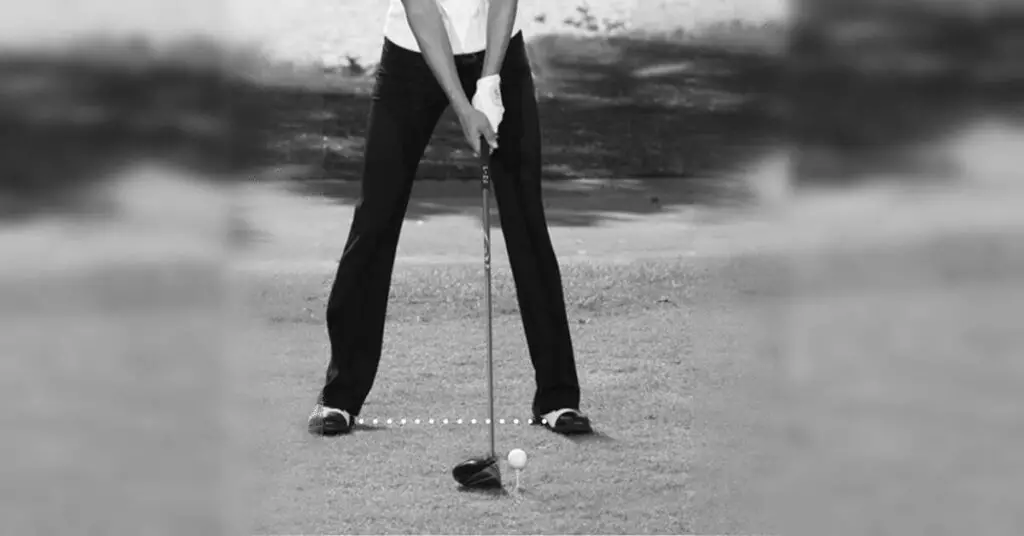
Fairway woods are slightly narrower as you don’t need as much rotation. A stance around shoulder width is optimal.
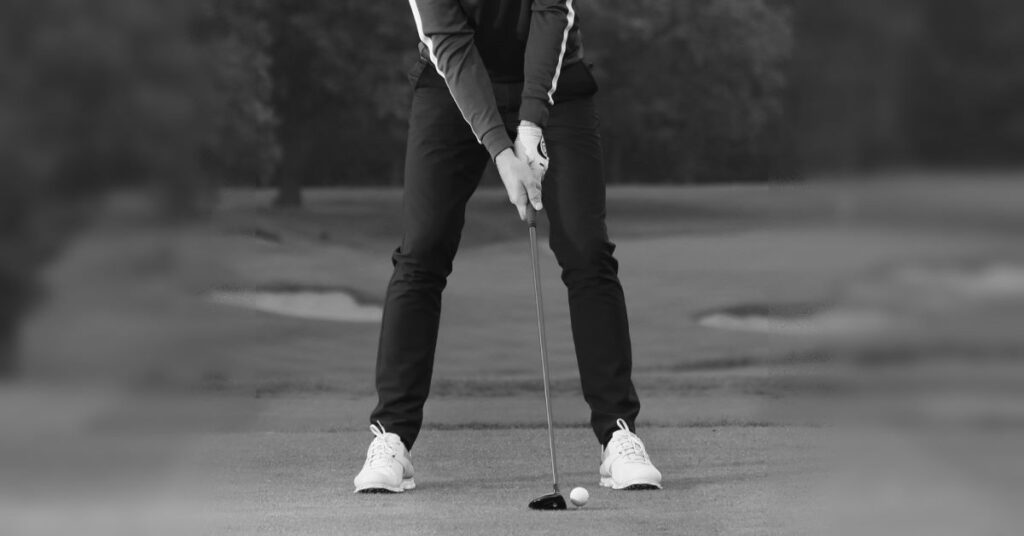
Long irons benefit from a moderate-width stance. Too wide and you reduce control. Too narrow and you limit power potential.
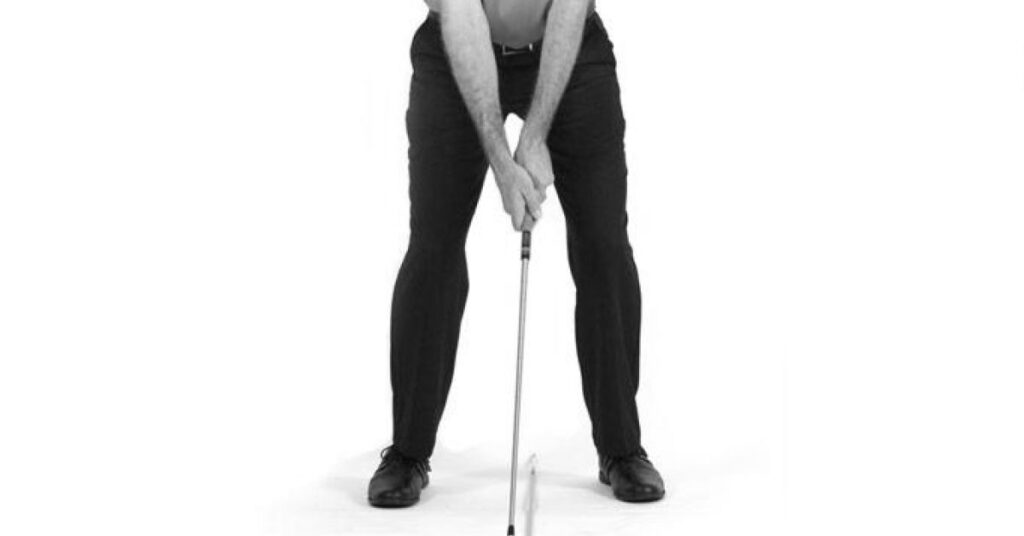
Short irons and wedges use a narrow stance for more control on short swings. Your feet should be just outside shoulder-width.

Terrain Variations
- Downhill lies require widened stances for balance. Your feet should be further apart to account for the slope.
- Uphill lies use narrower stances since the slope keeps you stable. Feet slightly closer together enhances control.
- Sidehill lies need uneven foot positioning – widen your uphill foot to handle the tilt.
Shot Shaping
- Draw shots use an open stance with your feet aimed left of the target to encourage an inside-out swing path.
- Fade shots use a closed stance with feet right of the target to promote an outside-in swing path.
Dialing in Ball Position
Ball position is also key – each club has an optimal impact spot on the face to launch the ball properly. Ball position should match this impact spot based on address:
- Driver: Inner toe of front foot – low on face for high launch angle.
- Fairway woods: Front heel – middle of face for moderate launch.
- Long irons: Center between feet – higher on face for flatter trajectory.
- Short irons: Front center – high on face for steeper launch, spin.
- Wedges: Front instep – very high on face for maximum spin and stopping power.
Maintaining Flexibility
While guidelines for stance width exist, it’s important to maintain some flexibility and adjust within your comfort zone for balance. Some variability is natural in golf. Focus on:
- Footing that feels athletic and balanced
- Width that allows free rotation and arm swing
- Proper spine angle, posture, weight distribution
- Adjustments to terrain, shot shaping as needed
Experiment to find optimal combinations of width and ball position for each club that groove consistency into your muscle memory through practice.
Fairway Woods
Fairway wood stances balance power and control since these clubs fill the gap between drivers and irons.
- Slightly wider than shoulder-width
- Knees relaxed, weight balanced
- Ball position near front heel
- Open or closed stance to shape shots
The moderate width provides stability to hit fairway woods cleanly from the turf off the tee or on longer approach shots.
Finesse Shots
For finesse shots around the green, stance promotes feel and flexibility.
- Feet narrowly outside shoulder-width
- Weight evenly distributed or slightly forward
- Ball position matches club and desired trajectory
- Relaxed knees and grip pressure
The narrower stance keeps you agile to make nuanced shots from tricky lies while maintaining stability.
Putting
Putting stances prioritizes posture, alignment, and rhythm over width.
- Feet hip-width apart, parallel to the target line
- Knees flexed, weight balanced
- Shoulders square, eyes over the ball
- Ball position varies based on preference
This compact posture focuses on connection with the putter face and smooth acceleration through impact.
Left vs Right: Tailoring Your Stance Based on Dominant Hand
Whether you are left or right-handed, your golf stance setup should optimize your balance, swing motion, and ball-striking based on your dominant side. While general stance fundamentals apply universally, lefties and righties require some tailored alignment tweaks and positioning to ingrain repeatability.
Right-Handed Golfer Stance Setup
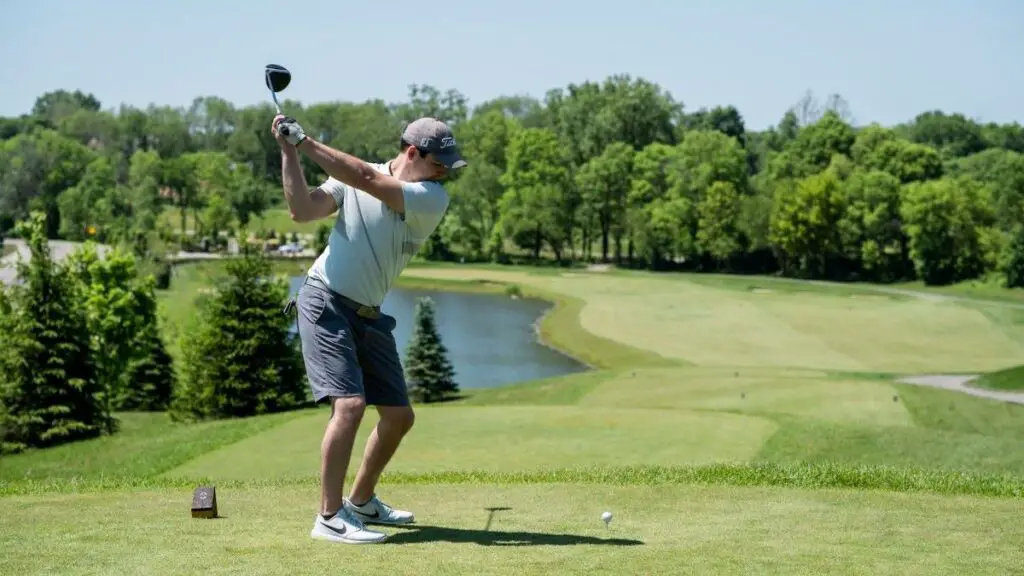
For righties, the proper stance aligns your left side to the target line. Your left side essentially controls the club path and delivery through impact, so you need to square up your left to swing the clubface directly into the back of the ball.
Start by positioning your feet shoulder-width apart with the left foot slightly ahead of the right. You want even weight distribution between both feet for balance. Next, ensure your shoulders are parallel to the target line, not aimed right or angled open. Gripping the club lightly, place the ball off your left heel instep with the clubface aimed at your target. This conventional righty setup orients all your major stance foundations correctly for repeating your swing.
Common errors right-handers make
Common errors right-handers make include standing too far from the ball, misaligning feet and shoulders right of the target, gripping the club too tightly, and improper ball position. Staying centered over the ball with feet set for optimal balance and shoulder alignment focused directly at your target makes a more reliable righty stance. Dialing in the proper ball position for each club also improves impact. A light, relaxed grip helps righties make a freer shoulder turn and arm swing without manipulating the clubface.
Left-Handed Golfer Stance Setup

For left-handed golfers, the opposite is true – your proper stance sets your right side to the target since your right side controls the swing path. Your feet should be shoulder-width with the right foot slightly forward, and your shoulders parallel to the target line. Weight balanced between feet, position the ball off your right heel instep when gripping the club with your right hand lower than left.
This left-handed setup squares your dominant right side to the target for ideal delivery through the ball.
Common errors left-handers make
Common errors lefties make are aiming feet and shoulders left of the target line, reaching for the ball, gripping too tightly, and improper ball position for the club. Focusing on aligning shoulders and feet to the target, proper ball position, and light grip pressure enhances a repeatable left-handed stance.
Regardless of being left or right-handed, consistently aligning your dominant side and foundations like ball position, posture, weight distribution, and alignment promotes solid contact and accuracy. Tailoring details based on your handedness ingrains proper swing mechanics and maximizes performance. Test adjustments at the range to optimize your personalized stance as a lefty or righty. Grooving fundamentals like balance, alignment, and ball position based on your dominant side enhances consistency.
Common Mistakes in Golf Stance and How to Correct Them
Setting up in a proper golf stance is crucial for consistency, but many amateurs make small mistakes that throw off their balance, aim, and swing. Being aware of the most frequent errors can help you self-diagnose issues and make corrections.
Standing Too Close or Far From the Ball
A common mistake is standing too close or too far from the ball during setup. The ideal distance allows you to reach the ball at the top of your backswing while still keeping it within a comfortable range. Stand far enough to make a full shoulder turn and shift your weight properly.
Foot Positioning Issues
Proper foot positioning establishes your base. Feet should be shoulder-width apart, with knees slightly flexed for athletic balance. Avoid standing pigeon-toed, duck-footed, or with your weight on your toes. Keep foot pressure centered on the arches.
Failing to Distribute Weight Evenly
Evenly distributing your weight between both feet aids stability. Don’t lean too heavily on your front or back foot. Balance your weight 50/50 for optimal stance.
Faulty Posture and Spine Angle
Good posture allows free rotation. Don’t slouch or tense your arms. Stand tall with chest lifted, spine straight, and shoulders relaxed. Match your spine angle to create space for your arms to swing.
Misaligned Feet and Shoulders
Align your feet, knees, hips, and shoulders perpendicular to your target line. Misalignment will send your swing off-plane.
Use alignment sticks and pay attention to positioning details. Ask for feedback from a coach. Ingraining proper setup and making adjustments corrects mistakes.
Drills to Improve Golf Stance
Ingraining proper stance setup requires practice and repetition. Try these simple solo drills at the range or home to groove an athletic, balanced address position.
Alignment Stick Drill
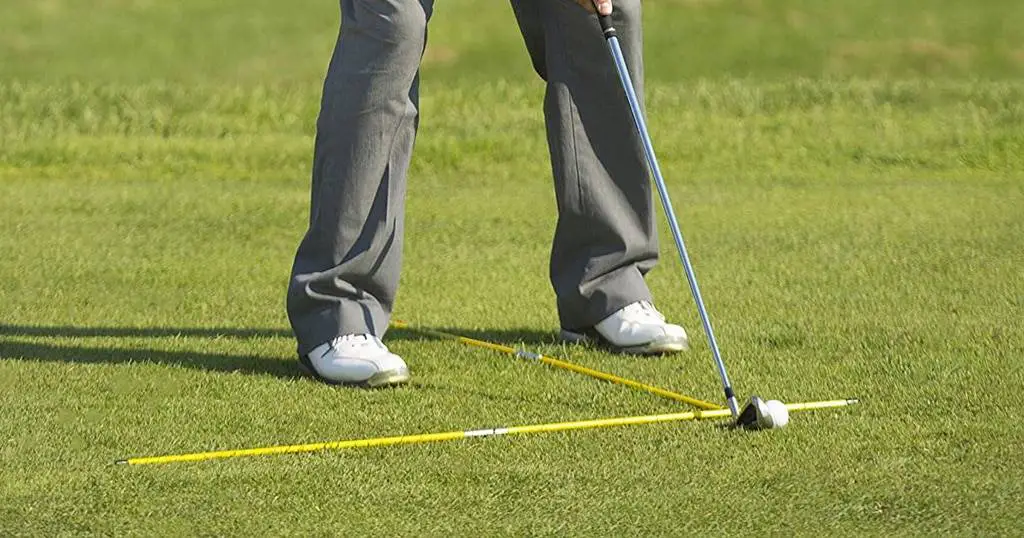
Place two alignment sticks on the ground – one parallel to your target line, the other perpendicular behind the ball. Set up to the ball, then step away and examine where your feet and shoulders are aligned relative to the sticks. Move into your address position focused on proper alignment.
Wall Drill
Stand with your back to a wall, heels touching it. Take your stance keeping heels, hips, and shoulders connected. Make practice swings by brushing the wall with your backswing to feel centered in rotation.
Balance Bridge Drill
Raise one foot a few inches off the ground during setup. Balance on one foot, then the other, while making mini swings. This enhances stability.
Foot Spray Drill
Spray footpowder on your shoes and take your normal stance over a ball. Step away to examine the footprint for proper distribution, angle, and width.
Half-Swing Drill
Take your stance then make smooth half-swings focused on keeping the lower body quiet while turning shoulders and arms together. Groove this motion.
Perform these simple drills regularly for improved golf stance technique.
Customizing Your Stance
While general guidelines exist for golf stance, truly optimizing your setup requires customizing based on your body type, club selection, and the lie or terrain. Making adjustments tailored to you ingrains repeatability and enhances performance.
Adjusting Stance Based on Body Type
The width and specifics of your stance should complement your physical proportions and flexibility.
Wider Stance for Taller Golfers
If you are tall or have a long torso, a wider than standard stance allows you to flatten your spine angle comfortably at address. Your arms and shoulders have more room to swing fully.
A width beyond shoulder width can reduce tension and improve rotation for golfers over 6 feet tall. Widening foot position also lowers your center of gravity for added stability.
Narrower Stance for Shorter Golfers
Shorter or petite golfers often benefit from a stance narrower than the standard shoulder-width apart guideline. This avoids over-stretching and discomfort.
Bringing feet closer together maintains balance and turn radius for golfers with shorter arm lengths. But don’t narrow to the point of instability or restricted swing motion.
Aim for a stance narrower than shoulder width, but no closer than hip-width apart. Keeping feet outside hip width prevents swaying. Find your optimal narrower stance through practice.
Match Stance Width to Flexibility
Regardless of height, ensure your stance width aligns with your flexibility levels. If your hips or shoulders are tight, narrow your stance to your comfortable range of motion.
If you are very flexible, a widening stance can enhance your turn while keeping stability. But don’t over-widen in a way that makes rotation feel loose or uncontrolled.
Adjusting Stance Based on Club Selection
Tuning stance width and ball position to each club promotes solid contact.
Wider Stance for Woods and Long Clubs
A wider stance adds power and stability for driving long clubs off the tee. Spread feet wider than shoulder width and align ball with front toe.
This athletic base lets you drive into the shot fully with balance. The extra width also prevents swaying on the backswing shift.
Narrower Stance for Wedges and Short Clubs
For finesse shots with higher lofted wedges around the green, narrow your stance to just outside shoulder width. Bring feet closer together for precision.
This compact stance keeps you nimble and able to adjust to tricky lies. With a narrower base, you can stand closer to the ball.
Adjusting Stance for Terrain Variations
Lie angles and uneven terrain require stance tweaks for balance and control.
Wider Stance for Downhill Lies
On sidehill or downhill slopes, widen your stance considerably for stability. Spread feet wider than usual to lower center of gravity.
Widening rear foot, especially on severe downhills keeps weight anchored into the slope. This prevents sliding or slipping.
Narrower Stance for Uphill Lies
For uphill lies, bring feet closer together in a compact stance. Narrowing the base aids control with the slope keeping you stable already.
Concentrate weight on your downhill foot on the incline. A narrower stance adjusts your balance point optimally.
Customizing the stance for your body, club selection, and course conditions improves repeatability. Groove adjustments through practice at the range.
Conclusion
A proper golf stance lays the groundwork for solid ball-striking and consistent shot-making. Your address position synchronizes the foundations of balance, posture, alignment, weight transfer, and ball position to optimize every swing. While stance basics like foot width and ball alignment depend on whether you stand left or right of the ball, optimizing your setup requires personalization.
This guide provided key considerations for tailoring your stance based on factors like body type, flexibility, club selection, and shot-shaping goals. The optimal foot position, width, ball placement, and posture vary based on your physical attributes and desired shot trajectory. Testing adjustments to fine-tune your personalized stance ingrains repeatability.
For right-handed golfers, focusing on aligning your left side to the target line while tuning width and ball position positions you to swing the clubface squarely into the back of the ball.
Left-handed players need the same emphasis on squaring their dominant right side at address.
Stance mistakes like improper alignment, weight distribution, or posture flaws require correction through conscious practice and drills.
While general guidelines provide a starting point, no one-size-fits-all stance exists. Finding your optimal foot position, stance width, ball placement, and posture for each club and shot shape takes experimentation. Even seasoned players revisit stance fundamentals and make continual refinements. Allow yourself flexibility in your address setup as you develop muscle memory.
With an athletic, balanced foundation tailored to your body and swing, you gain consistency in ball striking for both short-game touch and long-driving power. Dialing in your personalized golf stance alignment, width and posture build a platform to elevate your capabilities. Consistently aligning your body and optimizing your stance brings you one step closer to ingraining a tour-caliber repeatable golf swing.

